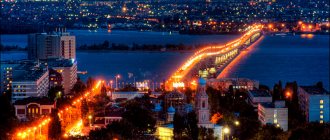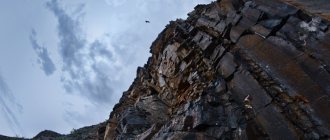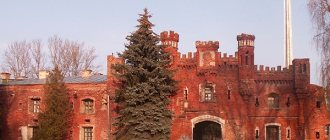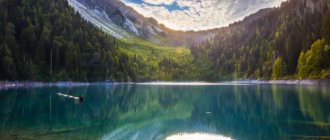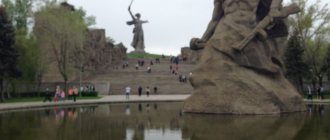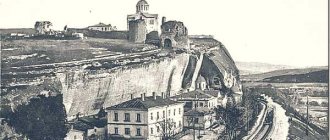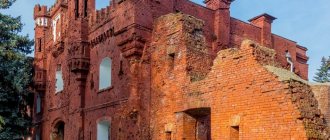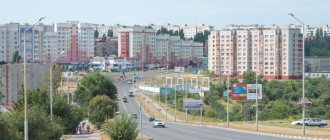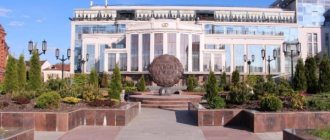Only the lazy have not written about castles and palace ensembles, churches, park complexes and natural attractions of the Grodno region. Of course, the “right” tourist will begin his acquaintance with the region by visiting these national treasures.
But if you are tired of serious art, ancient architecture and abstruse explanations of the guide, the Grodno region has something to surprise you. We bring to your attention places where you not only see the sights or visit museums, but also relax!
Museum of Prison Life
The most controversial, frightening and inaccessible museum in Grodno can safely be called the Museum of Prison Life, which is departmental and opened by “Prison No. 1” only two years ago.
If you manage to get on the excursion, be prepared to see a real checkered sky, instruments of torture, a model of the Grodno prison, a mannequin in a prison uniform, copies of prison cells from different eras, crafts made by prisoners, documents and a multimedia screen dedicated to the history of the prison, and much more. . Usually the excursion lasts about an hour, but you may not be able to see everything in one go.
The museum is located on Kirova Street, 6. You cannot get here “from the street”; you must sign up in advance, and excursions are only available for groups.
Church of Saints Simeon and Helen (Minsk)
One of the most recognizable and famous architectural monuments of the capital. The building is in the neo-Gothic style, located on the square. Independence. Local residents more often use another name - the Red Church, all because of the red brick from which it was built. Built at the beginning of the twentieth century on the initiative of public figure Edward Voinilovich. The church is topped with three towers, one large and two smaller.
Transport accessibility: Lenin Square metro station, bus route 100, 69, 1.
There is a Sunday school at the church and services are held.
Fire Service History Museum
The Grodno fire tower attracts the eye, if only because it towers solidly above the surrounding houses. Don’t be lazy and come closer - the facade will surprise you and will not leave you indifferent. At first glance, the fresco painted on the tower is dedicated to the history of the fire service, but take a closer look at the faces of the characters and you will see the real Mona Lisa, or rather her face.
The building itself houses a fire service history museum with four exhibition halls. The exhibitions tell about the history of the development of this service, and about major fires, and about the training of specialists in the city, about equipment and much more. Every day at noon the sounds of music are heard from the tower - a trumpeter in a historical uniform plays one of the works of Belarusian authors.
The museum is open from Monday to Friday, from 9:00 to 17:00, admission is free. It is better to clarify the time and possibility of a visit in advance by calling +375.
Nesvizh Castle
In ancient times, the castle was the family seat of a legendary family in the Polish-Lithuanian Commonwealth - the Radziwills. 16th century architectural monument. The ensemble consists of several objects: the castle itself, a landscape park and fortifications around it.
For several centuries, the castle held informal leadership - it was one of the most advanced defensive structures and was the base of the private army of an influential family.
In general terms, the territory of the complex tends to be symmetrical; in the center, the building, which is an architectural monument, is fenced on all sides by an embankment and a ditch filled with water.
Originally intended for military purposes, withstanding a long siege, over the centuries, the complex, after several reconstructions, turned into a romantic palace complex, surrounded by a beautiful park and included in the World Heritage List.
Kunstkamera
Yes, yes, this is not a mistake or a joke - in Grodno since 1958 there has been a real cabinet of curiosities, which belongs to the Department of Normal Anatomy of the Grodno State Medical University. It appeared along with the department, but at first it was available only to students. By the way, the exhibition is located where, according to legend, the body of Stefan Batory was opened for the first time in Europe.
The university’s collection was constantly replenished and in 1990, the Museum of Anomalies, Deformities and Mutations, where there were about 70 exhibits, was separated from the anatomical exhibition. Since 1994, lectures have been given at the museum, and in 2013 the exhibition was updated.
Now you can visit the museum both individually and in groups of up to 10 people. All proceeds from tickets and lectures go to the educational institution's foundation. The exhibition is open at st. K. Marx, 1 from noon to 18:00 except Monday and Tuesday. You can sign up for a tour by calling +375.
Brest
One of the oldest known Slavic cities in the past, today it is a major administrative center in the southwest of the country. An important transport hub: railway connections and river port. The areas around Brest are rich in natural monuments; several natural reserves are concentrated in this region (Bugsky, Brestsky, Barbastella and Pribuzhskoye Polesie).
Mukhavets, carrying its waters, divides the city in half; in the northern part there are historical quarters, mostly built up with buildings of the past and the century before last.
Popular tourist attractions in the city, the number of visits growing year by year, are: the Brest Fortress complex, St. Nicholas Cathedral and the fraternal church. It was in Brest that the Bernardine monastery functioned until the 17th century, its remains can still be seen, and for history buffs of post-revolutionary Russia it will be interesting to visit the Peter and Paul Church, because it was here that the famous Treaty of Brest-Litovsk was signed.
The legendary Belovezhskaya Pushcha is located within close proximity to the city. The most optimal way to build your route to the Pushcha is through Brest.
Pharmacy Museum
Not every pharmacy can boast of a centuries-old history, but the pharmacy-museum located on the central square of Grodno not only treats, but also educates. The pharmacy building is part of the Grodno Jesuit monastery complex and was built in 1709. What’s unique is that the pharmacy was located there almost all the past years, only for a while in the 50s of the 20th century, giving way to the Furniture Salon and the Teacher’s House. Fortunately, the unique historical building was not left without defenders and in 1996, restoration of the pharmacy began, and then a museum appeared in it.
It is now divided into three parts and offers three exhibitions. Here you can see an “alchemist’s corner” with herbs and cauldrons, medical and laboratory instruments, small pharmaceutical equipment, pharmaceutical advertising and newspapers from the early 20th century.
The pharmacy is located at Sovetskaya Square, 4, open seven days a week from 9:00 to 19:00. You can order an excursion or check the opening hours by calling +375
The town of Odelsk: the birthplace of that same priest Kondrusiewicz
– This is a small settlement in which there is a wooden church from the 18th century (and there are not so many of them on the territory of Belarus). Odelsk is also the birthplace of Tadeusz Kondrusiewicz , a Catholic archbishop.
In this place you should definitely visit the master Maryan Skramblevich - the instruments that he makes with his own hands are included in the list of intangible heritage of Belarus. You can come to him and enjoy the music, besides, he is a very interesting person - you can talk about a lot with him.
Odelsk is also famous for its cuisine – Lithuanian-Belarusian-Polish. There is a tasting of dishes, but in order to participate, you need to agree in advance with the local cultural center.
Where is it located: the agricultural town of Odelsk, Grodno district.
Glass Museum
One of the most visited objects by foreigners in the visa-free zone is glass and its museum. People come here both for real works of art made of glass and crystal, and for unforgettable impressions. Of course, it is not close to Grodno - about two hours by car, but the trip is worth it.
The museum tour includes a visit to the plant and an introduction to the entire production cycle. Guests of the enterprise can see how masterpieces are born in a flame, learn the secrets of making the famous Grodno smoky glass, and see how the transparent material is painted in all the colors of the rainbow. In addition, the museum displays exhibits that are more than a hundred years old, exclusive works by contemporary masters, and collections that have won at international exhibitions. Well, for those who want to bring a unique gift to their loved ones, there is a company store here.
The production and museum are located in the village of Berezovka (Lida district), Korzyuka Street, 8. You can arrange an excursion by calling +375, and the ticket price is 2.5 rubles for residents of Belarus and 4.5 for guests from the CIS and neighboring countries.
Mir Castle (Mir)
Construction date: 16th century.
The complex includes: a castle building, embankments and earthen ramparts, an artificial reservoir, landscaped parks and a manager’s residence.
The first owners, given the power and influence of the family, were also the Radziwills. It was the first privately owned castle on the lands of Belarus. The author of the project decided to create it in the Gothic style of architecture, which was fashionable in Europe at that time, and, as it turned out, this particular building became the most eastern Gothic castle in Europe.
Today Mir Castle is one of the centers of attraction for tourists. For the convenience of guests, there is a hotel, a restaurant, and bicycle rentals. For the first acquaintance, it is better to take a sightseeing tour, which, on average, lasts 70 minutes; in addition, several thematic ones are offered (Owners of the Mir Castle, Defensive features of the Mir Castle, Architectural objects of the complex, etc.)
Location: Grodno region, pos. World.
Iron Museum
The tiny but incredibly interesting Iron Museum is also popular among Belarusian and foreign tourists - the only one in the country. Perhaps this is a wonderful example of how an attraction is made from nothing. The collection of the museum, which opened a little over a year ago, contains more than 300 specimens and all of them can be touched, and some can be tried in action.
Coal and gas, cast iron and decorative, the size of a matchbox and huge multi-kilogram ones - all these are irons collected by enthusiasts in Belarus and abroad. By the way, in addition to a fun excursion, tourists will also find a kind of quest here - the opportunity to iron a linen tablecloth using a rolling pin and a ribbed board, following the example of our ancestors. The museum also has other kitchen utensils and a souvenir shop where you can buy something unusual as a gift to your friends.
The museum is located in Grodno on Sovetskaya Street, 7-23 (on the second floor, entrance from the courtyard), open from 10:00 to 18:00 on weekdays (except Mondays) and from 10:00 to 16:00 on weekends. Tickets for adults cost 4 rubles, for students - 3.5 rubles, for schoolchildren - 2.5 rubles, admission for preschoolers is free. You can sign up for a tour and get all additional information by calling 8 (029) 780-13-18.
Khatyn
There is no settlement with this name on any map of the world. The village of Khatyn was wiped off the face of the Earth by the Nazis in the spring of 1943, along with all its inhabitants. The memorial serves as a reminder to descendants of the atrocities that the citizens of our Motherland had to go through during the occupation.
The memorial has a photo-documentary exhibition, the first hall is dedicated to the Second World War, its beginning and the attack on the USSR, the second hall tells about the tragedy of Khatyn, Trostenets and other Belarusian villages, the third tells about the history of the creation of the memorial.
Location: Logoisk district, Minsk region.
The first zoo in Belarus
The oldest, and for a long time the only zoo in Belarus, is located next to the Grodno railway station, and therefore is often one of the first city attractions that tourists see. It has more than 3,000 thousand inhabitants, compactly located on the recently restored territory. It appeared in 1927, when a zoological department was opened in the botanical garden of the men's gymnasium. The founder is considered to be biology teacher Jan Kokhanovsky, and the first inhabitant is an ordinary beaver brought by a wounded man from Lunno.
In the first years, the number of species kept in the zoological garden grew to 30, and students from all city educational institutions in Grodno began to visit this place. Due to financial difficulties, since 1935, visiting has become paid.
During the Great Patriotic War, the zoo suffered greatly; valuable and rare specimens were taken to the Königsberg Zoo, and Kokhanovsky was shot. In the first post-war years, the zoo began to be restored, transporting it from place to place and replenishing the collection. Today there are such unique animals as the Sichuan takin, gray monitor lizard, Persian leopard, Amur tiger, and David's deer. The symbol of the Grodno Zoo is the bison (it is depicted on the zoo’s emblem).
The establishment is located at st. Timiryazeva, 11, open daily from 10:00 to 19:00, tickets for adults cost 5 rubles, for children over 3 years old - 3 rubles. For more information, please call +375.
THE SITE “PLANET BELARUS” HAS APPEARED A YANDEX ZEN CHANNEL. SUBSCRIBE!
Berezinsky Biosphere Reserve (Vitebsk)
The central estate of the reserve is located 3 kilometers from the Minsk-Vitebsk highway; the Domzheritsy checkpoint can be reached by buses and minibuses.
All conditions are provided to accommodate guests of the reserve. There are guest houses and hotel complexes. Vacationers have the opportunity to engage in hunting tourism and fishing, but only in agreement with the management of the reserve and in strictly designated places.
More than 60% of the reserve's territory is occupied by peat-bog soils.
Today, the reserve, in addition to its educational and tourist functions, plays the role of a large natural laboratory for environmental monitoring.
What to bring
Many masters of folk crafts live in Grodno, who are known for their ability to create original works from a variety of materials. A unique local school of artistic leather processing. Novogrudok has long been famous for its woven belts. Recently, firanks by Natalia Klimko have brought her fame.
The Grodno region has long established rich traditions in the field of ceramics production, which are especially developed in the Zelva and Korelichi regions. In addition, various linen products have become a recognized brand in this region.
From Lida, as a souvenir, you can bring products produced by the Natural Chocolate Workshop, as well as trout, which is bred near the city. In addition, this region is especially famous for its traditions of so-called “white” weaving.
Craftsmen working in the Shchuchinsky regional center of crafts create various handmade souvenirs, but dolls dressed in folk costumes of Ponemanya are especially popular. In Sopotskin, a unique school for making Easter eggs has developed and there is even a festival dedicated to them.
Results
Belarus is very rich in nature, architecture and historical monuments; in addition, here you can not only relax, but also improve your health at resorts. Due to the abundance of forests, Belarus is deservedly called “the lungs of the European continent”, a very open and friendly country, the patrimony of the Polish-Lithuanian princes, a land through whose territory columns of invaders swept several times - all this is about Belarus.
What annually attracts millions of tourists, literally, from all over the world, and not just from the CIS countries to Belarus? The answer is simple: reasonable prices, many cultural, architectural and historical heritage sites, picturesque forests, rivers and lakes and a kind, hospitable population.
Lake Svityaz (Valevka, Grodno region)
Lake Svityaz is considered the cleanest body of water in the country. The area of the mirror is 2.5 km², the length of the coastline is 5 km. The reservoir has an oval shape, with a smooth entrance into the water and without sudden changes in depth. There are many options for recreation and fishing. The lake is surrounded by dense mixed forest (mainly oaks and pine trees). The places here are very beautiful and therefore popular.
Entry and recreation on the reservoir are free, you only need to pay for accommodation at a local sanatorium or when renting housing in rural estates - there is a huge choice there. There are places for setting up a tent for free; if you use camping services, you will have to pay the cost of the place. There are only three equipped beaches on the lake.
From Minsk you can get to the lake by bus or private vehicle.
Location: Novogrudok district, Svityazyansky landscape reserve.
Cathedral Church of St. Francis Xavier (Grodno)
A less common name is Farny Church. One of the most significant monuments in the country. Built in the 17th century. Since its foundation, it has been famous for its expensive decoration; sculptures, paintings and other decorations are used in its interior. There are 13 altars inside. It is worth mentioning separately the unique fresco painting of the 18th century; it covers almost the entire church and includes several compositional scenes.
The real treasure of the church is the tower clock - the oldest in Europe (15th century) - it still regularly counts the seconds.
Location: Grodno, sq. Soviet.
Naroch National Park (Naroch)
Located in the north-west of the country, in the Belarusian Lake District, the main task is to preserve the natural complexes united by Lake Naroch.
The structure of the institution consists of: forestry, scientific department, tourism, environmental and hunting sectors. There are hotels, cottages, an arboretum, and a car camping site on the territory.
The park includes more than thirty (!) reservoirs, where there is paid and free fishing; hunting is allowed only in designated areas and within certain periods.
Historical complex "Stalin Line"
This historical object rightfully bears the title of the largest, most realistic of the restored objects of the military heritage of the USSR. The most complete and in excellent condition exhibition of the museum is displayed in the open air. The fortification area, bunkers, caponiers for artillery, and control points were recreated from scratch. “Stalin Line” was opened on the 60th anniversary of Victory in the Great Patriotic War.
There are excursions here, you can ride on military equipment of those years, an armored train, shoot from various types of weapons, including from an armored train!
Location: Loshany village, 20 km northwest of Minsk.


